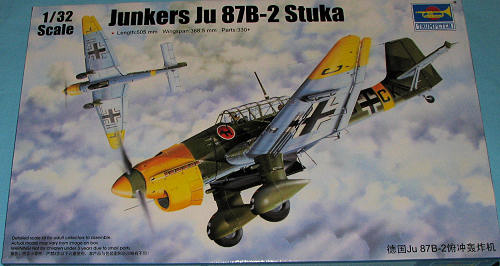
Trumpeter 1/32 Ju-87B-2 Stuka
| KIT #: | 03214 |
| PRICE: | $87.99 SRP |
| DECALS: | Three options |
| REVIEWER: | Scott Van Aken |
| NOTES: | New tool kit |

| HISTORY |
The Junkers Ju 87 or Stuka (from Sturzkampfflugzeug, "dive bomber") was a two-man (pilot and rear gunner) German ground-attack aircraft. Designed by Hermann Pohlmann, the Stuka first flew in 1935 and made its combat debut in 1936 as part of the Luftwaffe's Condor Legion during the Spanish Civil War.
The aircraft was easily recognizable by its inverted gull wings, fixed spatted undercarriage and its infamous Jericho-Trompete ("Jericho Trumpet") wailing siren, becoming the propaganda symbol of German air power and the blitzkrieg victories of 1939–1942. The Stuka's design included several innovative features, including automatic pull-up dive brakes under both wings to ensure that the aircraft recovered from its attack dive even if the pilot blacked out from the high acceleration.
Although sturdy, accurate, and very effective, the Ju 87 was vulnerable to modern fighter aircraft, like many other dive bombers of the war. Its flaws became apparent during the Battle of Britain; poor manoeuvrability and a lack of both speed and defensive armament meant that the Stuka required heavy fighter escort to operate effectively.
The Ju 87 B series was to be the first mass-produced variant. A total of six pre-production Ju 87 B-0 were produced, built from Ju 87 A airframes. Test flights began from the summer of 1937. A small number, at least three, served as conversion Cs or Es for potential naval variants.
The first production version was the Ju 87 B-1, with a considerably larger engine, its Junkers Jumo 211D generating 1,200 PS (883 kW, 1,184 hp), and completely redesigned fuselage and landing gear. This new design was again tested in Spain, and after proving its abilities there, production was ramped up to 60 per month. As a result, by the outbreak of World War II, the Luftwaffe had 336 Ju 87 B-1s on hand. The B-1 was also fitted with "Jericho trumpets", essentially propeller-driven sirens with a diameter of 0.7 m (2.3 ft) mounted on the wing's leading edge directly forward of the landing gear, or on the front edge of the fixed main gear fairing. This was used to weaken enemy morale and enhance the intimidation of dive-bombing. After the enemy became used to it, however, they were withdrawn. The devices caused a loss of some 20–25 km/h (10-20 mph) through drag. Instead, some bombs were fitted with whistles on the fin to produce the noise after release.
The trumpets were a suggestion from Generaloberst Ernst Udet (but some authors say the idea originated from Adolf Hitler). The Ju 87 B-2s that followed had some improvements and were built in a number of variants that included ski-equipped versions (the B-1 also had this modification), and at the other end, with a tropical operation kit called the Ju 87 B-2 trop. Italy's Regia Aeronautica received a number of the B-2s and named them the "Picchiatello", while others went to the other members of the Axis, including Hungary, Bulgaria and Romania. The B-2 also had an oil hydraulic system for closing the cowling flaps. This continued in all the later designs.
The tropicalised versions were initially named the Ju 87 B-2/U1. This was eventually designated the Ju 87 B-2 trop, equipped with tropical emergency equipment and sand filters for the powerplant.
Production of the Ju 87 B started in 1937. 89 B-1s were to be built at Junkers' factory in Dessau and another 40 at the Weserflug plant in Lemwerder by July 1937. Production would be carried out by the Weserflug company after April 1938, but Junkers continued producing Ju 87 up until March 1940. Total production amounted to 697 B-1s (311 by Junkers, 386 by Weserflug) and 225 B-2s (56 by Junkers, 169 by Weserflug). The last Ju 87B rolled off the production lines in October 1940
| THE KIT |
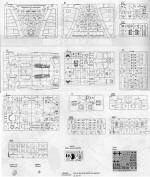 It
was great to see this kit being produced. I have always liked the Stuka, despite
its rather ungainly looks. This is, of course, not the only 1/32 Ju-87 on the
market with Revell doing a B model back in the dark ages of plastic modeling and
Hasegawa producing some very nice later versions. This one by Trumpeter is the
first new tool B model to hit the shelves in a very long time and it is most
welcome.
It
was great to see this kit being produced. I have always liked the Stuka, despite
its rather ungainly looks. This is, of course, not the only 1/32 Ju-87 on the
market with Revell doing a B model back in the dark ages of plastic modeling and
Hasegawa producing some very nice later versions. This one by Trumpeter is the
first new tool B model to hit the shelves in a very long time and it is most
welcome.
Typical of Trumpeter, you get a lot of parts and a lot of detail. The engraving is very well done and quite appropriate for this scale. I cannot comment on the accuracy of the kit as I really do not care all that much about breaking out the ruler and comparing the kit to plans, but I can bet that there are those out there who have. What I did see is that the propeller blades look a bit broad for an early war plane, but that is just me and they may well be perfect.
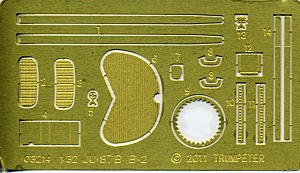 The kit
comes complete with an engine as well as a most well detailed cockpit and
gunner's position. There is a photo-etch set that includes some cockpit bits
like belts, handles, the ring around the rear canopy for the gun and such. The
front radiator grille is also in photo etch as are straps for the fuel tanks and
some detail bits for the guns to name a few. The kit provides rubber or vinyl
tires and even suggests these be painted later in the instructions. I am going
to go out on a limb and suggest that these maybe deformable styrene if they have
you paint them as rubber and vinyl do not hold paint well at all.
The kit
comes complete with an engine as well as a most well detailed cockpit and
gunner's position. There is a photo-etch set that includes some cockpit bits
like belts, handles, the ring around the rear canopy for the gun and such. The
front radiator grille is also in photo etch as are straps for the fuel tanks and
some detail bits for the guns to name a few. The kit provides rubber or vinyl
tires and even suggests these be painted later in the instructions. I am going
to go out on a limb and suggest that these maybe deformable styrene if they have
you paint them as rubber and vinyl do not hold paint well at all.
There are two hefty wing spars to put into the fuselage halves before closing them. These should support the wing without any issues at all. I appreciate that the flaps and ailerons have molded in attachment points where they glue to the wing. This should make for a sturdy construct of what could be a real paint to attach. The ailerons, flaps, rudder and elevators are all separate, but the way the kit is designed, they are all to be built in the neutral position. The dive brakes, however, are not. They are to be built deployed. This is a bit odd as they are normally in the stowed position when on the ground.
There are a goodly number of things to go under the wings. Starting with the main load is a HUGE bomb that has to be 1,000kg (well, it looks that large). Normal load under the fuselage is 250 kg. Then there are four different options for under the outer wings. One is a set of fuel tanks, which actually makes the aircraft a Ju-87R and not a Ju-87B. Then there is a twin mount for two smaller (perhaps 50kg) bombs. There are also racks which each hold five smaller bombs (5kg?). Two of these smaller racks fit under each wing. Finally, there is what looks to be a gun pod of some sort. I have to tell you that with the huge main bomb, there is no way the plane would have any sort of decent range and probably would be unable to carry anything under the wings. But these are options that are available to you should you decide to really load things up.
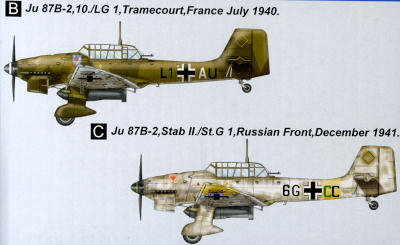 Instructions
are the usual landscape booklet that come with large kits like this and provides
color information in a variety of paint brands as well as the appropriate RLM
colors. These are all going to be RLM 70/71/65 which are the standard bomber
colors. The box art plane is from 2./St.G.2 in Russia during late 1941. As such,
it has a yellow nose, fuselage band and lower outer wing tips. The next is from
10/LG.1 in France during July 1940. It has a white ring around the s
Instructions
are the usual landscape booklet that come with large kits like this and provides
color information in a variety of paint brands as well as the appropriate RLM
colors. These are all going to be RLM 70/71/65 which are the standard bomber
colors. The box art plane is from 2./St.G.2 in Russia during late 1941. As such,
it has a yellow nose, fuselage band and lower outer wing tips. The next is from
10/LG.1 in France during July 1940. It has a white ring around the s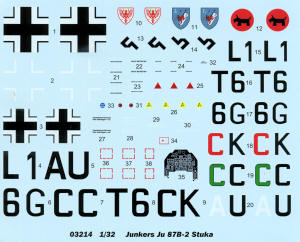 pinner.
The third is from Stab II./St.G.1 in Russing during December 1941. It also has
yellow under the outer wing tips and a yellow fuselage band. The standard camo
has been covered with a thin winter wash. Decals are well done and include one
for the main instrument panel. There are no extra decals bits for where the
lower wing insignia go over the dive brakes. I did notice that the unit badge
for the second option is not that well done in that the devil riding the bomb is
redder over the bomb than it is above it. This is due to not backing the entire
decal with white, which allows the red to be subdued where there is no white
background. Those wanting aftermarket decals should not have to wait long, or
they can use some of the sheets developed for the Revell kit.
pinner.
The third is from Stab II./St.G.1 in Russing during December 1941. It also has
yellow under the outer wing tips and a yellow fuselage band. The standard camo
has been covered with a thin winter wash. Decals are well done and include one
for the main instrument panel. There are no extra decals bits for where the
lower wing insignia go over the dive brakes. I did notice that the unit badge
for the second option is not that well done in that the devil riding the bomb is
redder over the bomb than it is above it. This is due to not backing the entire
decal with white, which allows the red to be subdued where there is no white
background. Those wanting aftermarket decals should not have to wait long, or
they can use some of the sheets developed for the Revell kit.
| CONCLUSIONS |
To repeat myself, I am very pleased to see this kit released. I have always liked the early versions and now we have a modern molding of this type in 1/32 to add to our collection. It is not inexpensive, but with over 330 parts, it is also not a snap kit and well worth what you get. The Ju-87 is not a small aircraft.
| REFERENCES |
http://en.wikipedia.org/wiki/Ju-87B
May 2012
Thanks to Squadron Products for the preview kit. Get this one today at your local shop or ask them to order it for you.
If you would like your product reviewed fairly and fairly quickly, please contact the editor or see other details in the Note to Contributors.